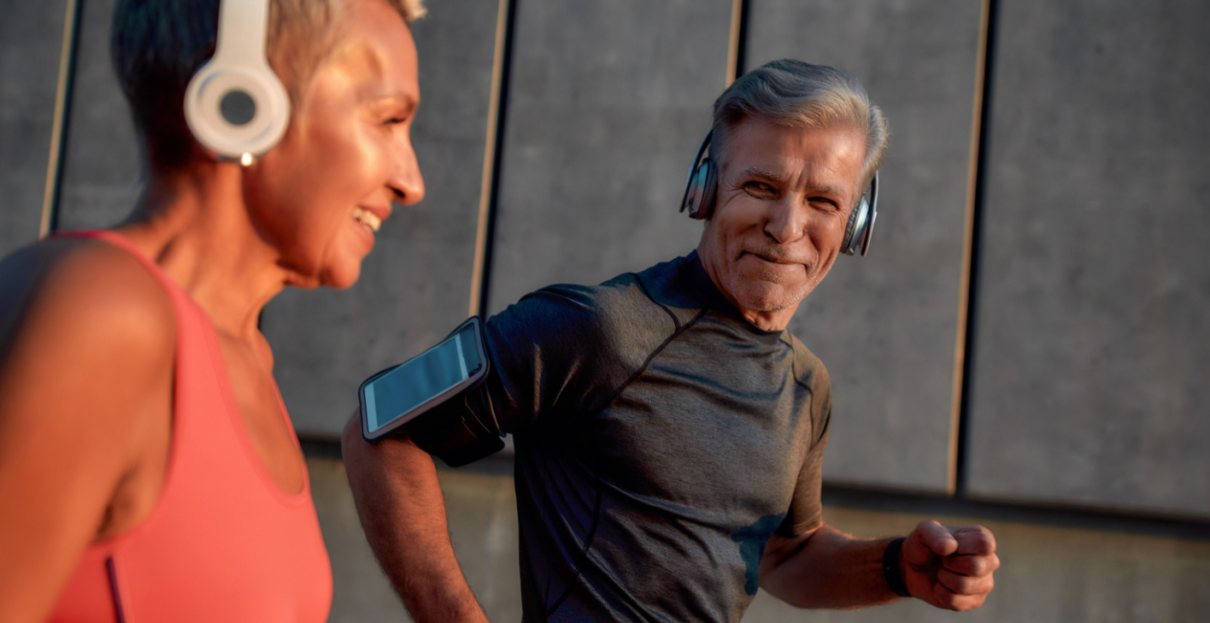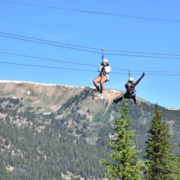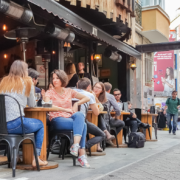New Generation of Active Agers Raises the Bar for Older Adult Fitness
By Margy Bartley
Two weeks ago, teaching my adult 60+ group fitness class at the Indianapolis YMCA, I called out, “I’m getting new music for next week. Any requests?”
“Yes! 70’s!” someone shouted from the back of the room,
Once again, I was reminded of how much group fitness for older adults has changed. It is no longer about people sitting in a chair and waving their arms or tapping their feet to big band music at 110 BPM. Today it’s about cardio kicks, high-knees, grapevines, and compound strength training movements with dumbbells (like squats with bicep curls rising to overhead press), all to the tune of 128-130 BPM rock n’ roll. These are older adults who grew up on Elvis, The Beatles, and The Rolling Stones, not Glenn Miller and Bing Crosby.
Instructors and personal trainers like me who have worked with this demographic over the years have had to move (literally) with our groups to match the new pace they are setting. Seventeen years ago, the Active Older Adult fitness instructor certification training I received was mainly focused on what NOT to include in a class for older adults:
Don’t do standing exercises because they might have poor balance.
Don’t raise arms over head because they might have shoulder issues.
Don’t rotate legs too much because they might have hip issues.
Don’t raise heart rate because they might have cardiac issues.
Don’t walk around much because they might have weak dorsiflexion.
Don’t turn heads too far because they might have neck issues.
The don’ts went on and on. There was little focus on what older participants could do or how to develop or recover lost ability.
As a result, participants were kept moving but not challenged. The goal of the class was pretty minimal, to maintain activities of daily living such as putting on coats, reaching to put on socks and shoes, and being able to comb the hair on the back of your head. There was little to no focus on increasing fitness levels. Setting such a low bar for what was achievable often had a negative impact on motivation and attendance. As one sweet lady in an Active Older Adults class once told me, “I feel like I do more at home moving around than in exercise class where I have to stay seated all the time!”
To be fair, these older adult fitness classes were circumscribed by the prevailing view of aging at the time. Doctors and family members were quite conservative and outspoken about what they did and did not consider safe for their older patients and relatives to do.
Another factor was that, twenty years ago, women entering their 60-80s had no experience with strength training or participating in a formal exercise program. They complained about sweating and did not like how it felt or how it looked. While they felt they should be allowed to stand and move, they were decidedly uninterested in lifting weights or working past the point of even mild exertion. They had zero experience with gyms or gym equipment so their comfort levels were low.
In contrast, the population entering retirement age today—a group increasingly referred to as “Active Agers” (a term I prefer)—want to be, and are used to being, physically active. They aspire to hike, go on long bike rides, travel, and be active with their families for as long as possible, and they’re willing to work diligently to achieve those goals. They don’t accept fatigue and chronic pain as a given and don’t want to rely on medications. When they walk through the doors of the fitness center, they have clear goals in mind, and we would do them a great disservice if we put them in a room, told them to sit down, and basically minimized the abilities they already have. Don’t get me wrong, there is nothing wrong with chair exercise, and chronic pain is an unfortunate reality for some. But in both of those cases, unlike in past decades, the hope today would still be to progress over time to standing movements and greater strength and flexibility.
A big advantage today is that older adults have much more familiarity with gyms and gym equipment and are no strangers to strength training. Even if they don’t possess experience, they are less hesitant to attempt it, especially in the company of a group fitness class with a knowledgeable trainer who can break goals down into manageable steps that build success, confidence, and self-efficacy. New evidence-based fitness programs for older adults emphasize functional fitness around strength and balance in environments that support “pushing” clients to meet specific goals and achieve measurable outcomes. Professional training and certification programs are catching up with this evolution and offer a wide range of fitness programs for older adults, like the American Council on Exercise’s Cognified Fitness and Power Training for Powerful Aging.
Healthcare providers have also tuned into older adult fitness trends. In the last year alone, I’ve had roughly 8-10 individuals over the age of 70 ask about personal training because their healthcare provider encouraged them to try it. I hear from older adults who, thanks to their healthcare provider’s confidence, feel emboldened to push back against family members who don’t want them to exert themselves shoveling snow or carrying heavy bags. From Dina, age 74, who asked me about kettlebells and who used a BOSU for the first time, to Jocelyn, age 75, who set a goal of increasing her core strength, to Henry, age 76, who goes to the gym after every group fitness class so he can focus on his leg strength post knee surgery—the Active Agers are setting the bar higher and becoming a force to be reckoned with. I’m excited to see where they will go next, and how I can support them in their active aging journey!
Margy Bartley is National Board Certified Health & Wellness Coach who has worked in the fitness industry for 30 years and with the older adult population for the last 20 years. She views aging as an opportunity to experience continued joy in physical movement.




